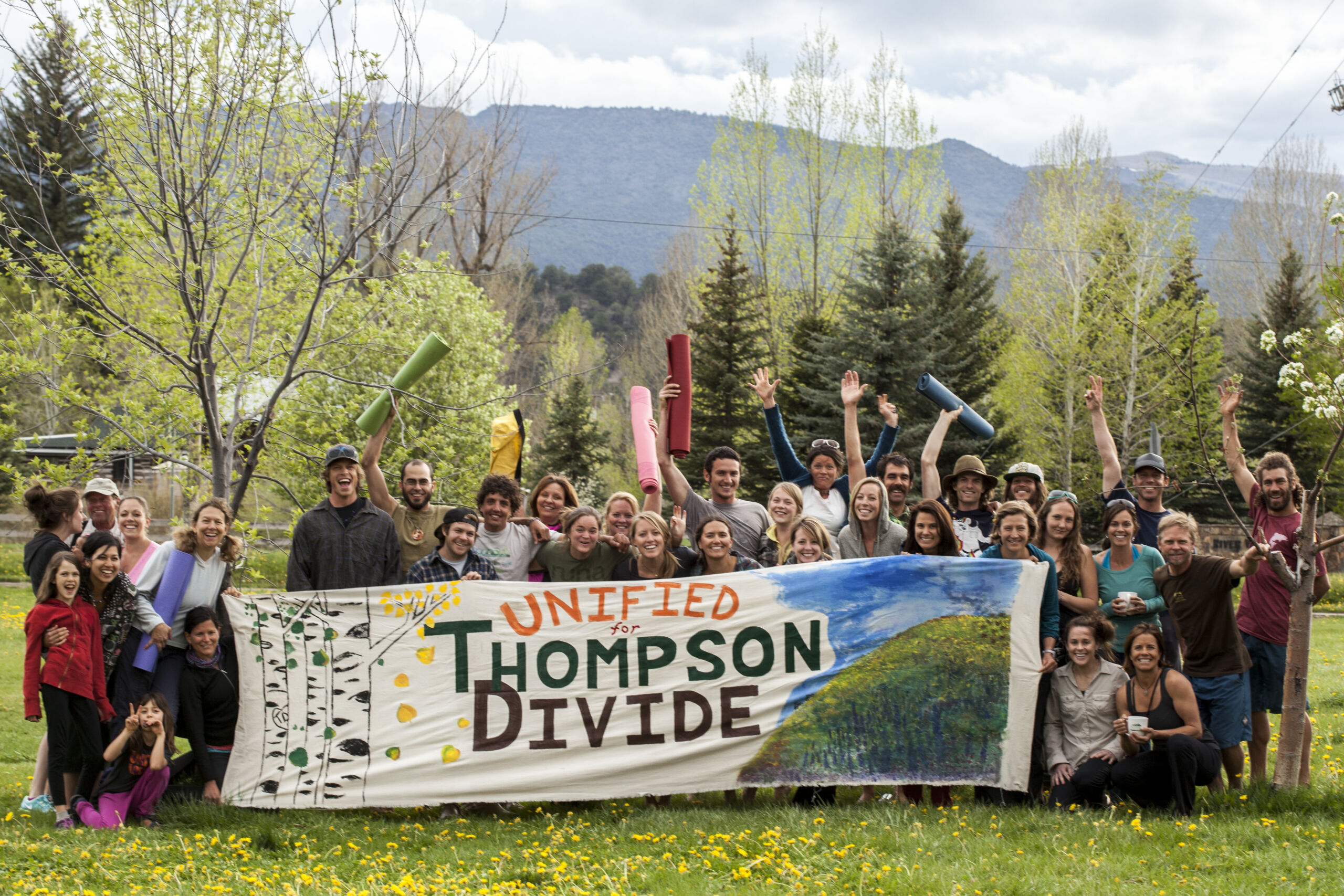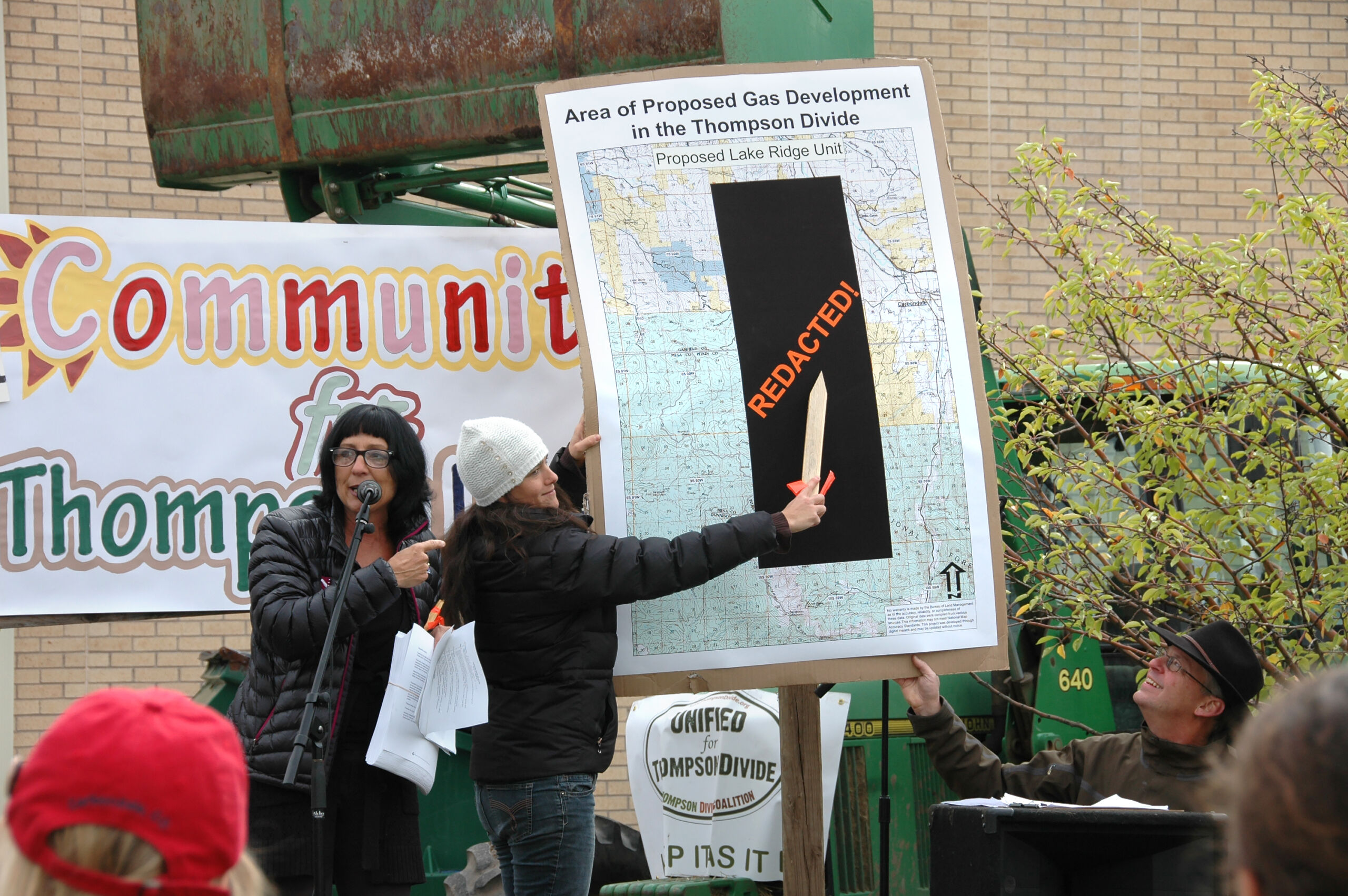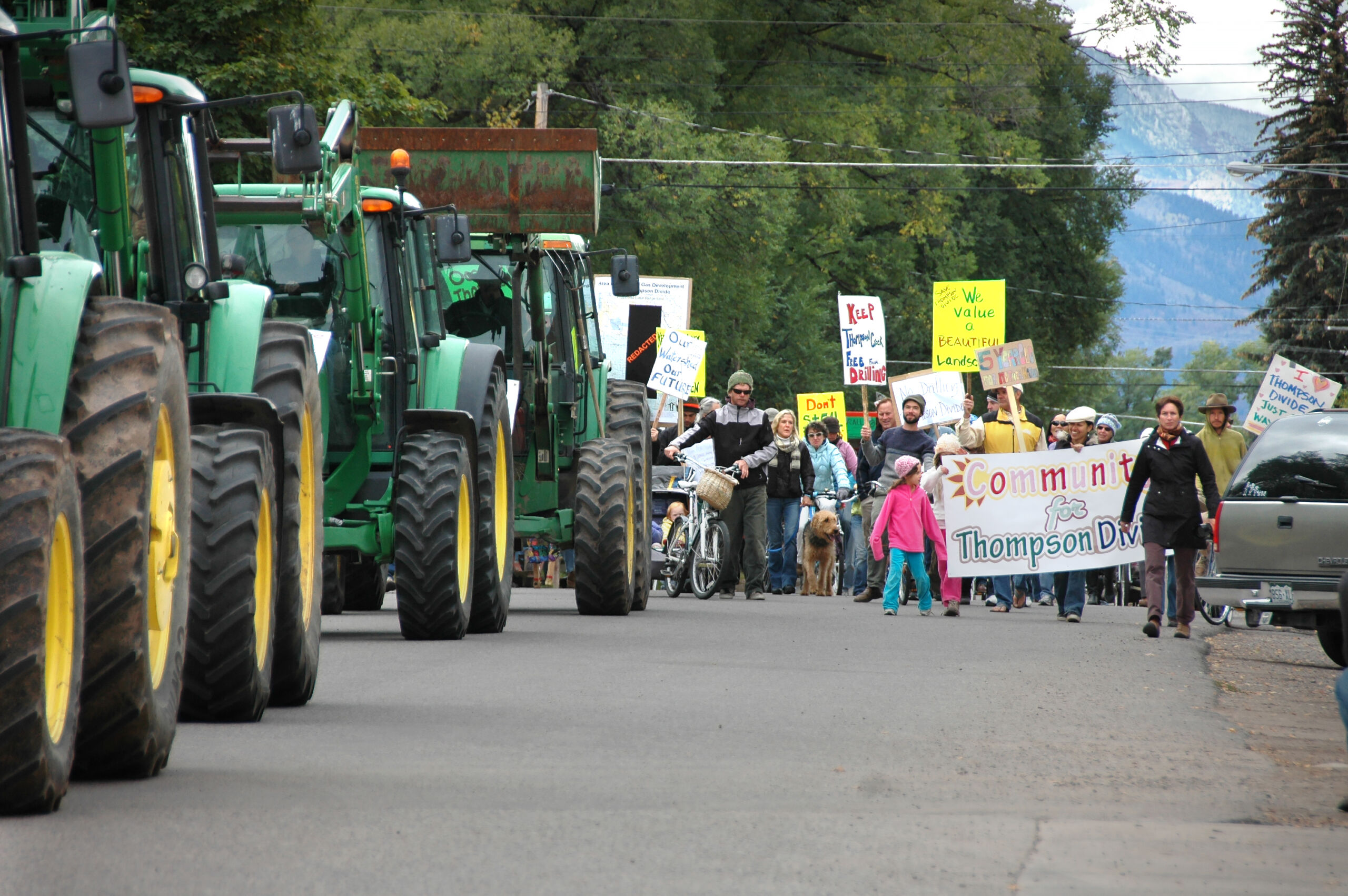
Unprecedented: How a Small Community in Western Colorado Saved a Quarter Million Acres of Public Lands
There was a time when the Thompson Divide didn’t have a name. The 225,000-acre expanse of public land overlays four counties, two national forests, four Bureau of Land Management (BLM) Field Offices, and 12 watersheds. The area spans the mid-elevation wildlands south from Glenwood Springs over McClure Pass and into the Ragged Mountains, and runs west from Carbondale through Coal Basin, spilling into the headwaters of Divide Creek (which flows into the Colorado River) and Clear Creek (a tributary to the North Fork of the Gunnison River).
Early on, Wilderness Workshop staff recognized the ecological importance of the area through detailed ecological inventories. The area serves as critical habitat for the endangered lynx, and is home to moose, elk, deer, bear, and mountain lions. The Divide connects important habitat near Grand Junction to the spine of the Rocky Mountains in the Elk Mountains. The area also boasts one of Colorado’s largest aspen groves, a vast network of roadless areas, essential grazing allotments for nearby ranches, and some of the most desirable hunting units in the western United States.
In the early 2000s, many community members had a stake in the area but most were focused on their small piece–which might be set away from neighbors by 10,000 foot ridges, mountain passes, or vast swaths of forestland.
The area was special–on that everyone agreed. But this land was under threat.
In the early 2000s, a post-9/11 Bush Administration sold more than 80 oil and gas leases across 100,000 acres in the area. The leases were sold cheap–many for the legal minimum of $2/acre and, as Wilderness Workshop would later discover, without complying with laws requiring public input and environmental analysis.
The threat of development didn’t sit well with the community. Bucolic lands and wildlife habitat just west of the Divide rapidly lost their pastoral charm and transformed into a spiderweb of roads, pipelines, pumping stations and fracked wells. Divide Creek, which flows out of Thompson Divide, made center stage when local residents were featured lighting their tap water on fire in Gasland–the documentary exposing the impacts of fracking on communities across the nation.
The imminent threat to the area’s unique ecological and community values brought strange bedfellows and distant neighbors together, and unified them in a desire to protect the Thompson Divide.
“We got a coalition of diverse stakeholders together, pulled out the maps, and asked everyone to draw a boundary around the area they thought needed protection for whatever their interest–whether it was grazing, wildlife habitat, mountain biking, climbing, snowmobiling, camping, watersheds, hunting, or roadless areas,” says Peter Hart, Legal Director at Wilderness Workshop, who has worked on the Thompson Divide for 15 years. “We then took all the maps, overlaid them, and that was the original boundary.”
The name “Thompson Divide” was an amalgam of Thompson Creek and Divide Creek, two of the most prominent drainages in the area.
Two Strategies Emerge
The campaign to protect the Thompson Divide formally began about 2008 on kitchen tables and in coffee shops around Carbondale. In 2009, the Thompson Divide Coalition (TDC) was formally established and the “odd bedfellows” started to get attention. The papers described the coalition as composed of “numerous owners of ranches or other property in the area; recreationalists; hunting and fishing groups; and several conservation groups.” If you live in western Colorado, you can appreciate the rarity of these nontraditional allies putting aside their differences to keep a piece of the wild intact.
The community got to work immediately, attending town halls, educating the public, building political support, gathering signatures and giving presentations to anyone willing to lend an ear.
Two main strategies emerged as a result of community engagement: first, something had to be done about the 80-some existing leases to ensure the area wasn’t drilled and industrialized. Second, permanent protections were needed to prevent future leasing and development.
The “Colorado Concept”
By 2009, there were more than 80 leases in the Thompson Divide. It was a shock and wake up call to the community and, in particular, the ranching community who had run cows and stewarded the meadows and forests of the Thompson Divide for generations.
Shortly after formation of TDC in 2009, the coalition decided to make a good-faith effort to buy out the existing leases in the Divide. Wilderness Workshop supported this work by filing Freedom of Information Act (FOIA) requests and gathering as much information as possible on each of the leases. We found that the oil and gas companies, or leaseholders, had paid about $2.5 million to acquire and maintain all of the leases in the Divide. TDC used the intel to inform an offer to buy out the existing leaseholders and reimburse them for all of their expenses.
The offer had support from towns and counties in the region. As an article in The Denver Post explained, “The core of the Colorado concept — endorsed by Garfield, Pitkin and Gunnison county commissioners — is that the economic value of pristine mountain land outweighs the value of oil and gas that could be extracted.”
Despite this market-based approach, the leaseholders did not bite on the offer. Instead, around the same time, they began filing drilling proposals on the leases. Suddenly, the threat of drilling seemed very real.
But one thing wasn’t clear: if the Thompson Divide leaseholders actually wanted to develop their leases, why did they wait so long to propose drilling? Federal oil and gas leases are issued for 10-year primary terms. Many of the leases in the Divide were nearing expiration.
As Wilderness Workshop worked to review the leaseholder proposals, the intent became clear. The proposals included a small number of drilling applications combined with ‘unitization’ and ‘suspension’ requests. The unit proposals grouped many leases together as one, relieving leaseholders from legal obligations to drill each lease before the end of its term. Then the suspensions were intended to put everything on pause while leaseholders pursued various approvals necessary for development–approvals that they’d failed to even apply for until the leases were set to expire.
Basically, leaseholders intended to use loopholes in BLM’s oil and gas regulations to prevent their leases from expiring without actually drilling. Fortunately, Wilderness Workshop’s deep dive into the lease records had exposed a host of other problems with the Thompson Divide leases. This is when the fight really began.
“Leaseholders weren’t biting on the offer and they were threatening to develop the leases,” says Will Roush, Executive Director of Wilderness Workshop. “There were fundamental legal problems with the leases, so we turned our advocacy towards the BLM. That’s when ‘void the leases!’ became a popular slogan and everyone asking BLM to do the right thing and cancel the leases.”
Extraordinary and Broad Support
Alongside our work to get the leases canceled, the second priority of Wilderness Workshop and our partners in the Thompson Divide Coalition was to secure permanent legislative protection for the Divide. “Absent other protections, public lands are generally available for all sorts of development, including oil and gas drilling,” says Roush. “Unless Congress passes a bill that says this area is ‘withdrawn’ or off limits to oil and gas leasing the threat of development will always remain.”
In order to get legislators and politicians on board, the community needed to show extraordinary and broad support. TDC and the Workshop didn’t have lobbyists in D.C., but we did have the support of a unified local community, including local ranchers–and their tractors.
In what would be the first of many such moments, on a sunny fall afternoon in 2011, hundreds of residents gathered outside the Third Street Center, where many took to the stage and waxed poetic about their love of the Divide. Then every local farmer brought their tractor and caravanned down Main Street leading a parade of supporters—many clad in costumes and carrying signs. As the front-page of The Sopris Sun read, “Nearly 300 people showed up for a rally at the park behind the Third Street Center that featured petitions to the federal government, a variety of speakers, music and a strong message of support for the work of the Thompson Divide Coalition.” It was a show of unanimity and highlighted uncommon allies unified by a common cause. The odd bedfellows speaking with one voice began to make front page news, and the issue of the Thompson Divide became a regular highlight in news roundups circulated to elected officials from Denver to D.C.
In 2013, this community support inspired U.S. Senator Michael Bennet to introduce the Thompson Divide Withdrawal and Protection Act. The legislation would have banned future oil and gas leasing in the Divide, and provided a mechanism for current leases to be donated, exchanged, or relinquished. As reported in The Crested Butte News, “According to the senator’s office, the bill was drafted at the request of local governments acting on feedback from leaseholders, elected officials, and community leaders.”
“There are places in the state, in this country, where it makes sense to drill, and there are other places where it doesn’t make sense to drill,” Bennet told a cheering crowd in downtown Carbondale after the bill’s introduction. “I admire very much the spirit of collaboration that you guys have demonstrated and modeled for the rest of the state.”
The strategy worked. Lawmakers took notice. Our community had a champion in Congress.

A “Sense of Place”
When the oil and gas boom started in the early 2000s, it was fueled by politics and by dramatic advancements in oil and gas drilling technology (e.g. fracking geologic deposits that were previously uneconomic to drill). Wilderness Workshop was ahead of the curve, advocating for federal agencies to update old oil and gas plans that failed to consider these advancements and their potential impacts (think: air, water, and public health effects from fracking). We used the threat of drilling in the Thompson Divide to demand a revision of the White River National Forest’s Oil and Gas Leasing Plan, and the campaign helped generate an extraordinary amount of public attention on the issue.
In 2015, as a result of years of tireless community and legal advocacy, the Forest Service banned new oil and gas leasing for 15-20 years across tens of thousands of acres in the Divide to new leasing through its Oil and Gas Leasing Plan. It was a huge win for the community and for the Divide, and it set the stage for subsequent victories.
Scott Fitzwilliams, the White River National Forest Supervisor, said the public had indicated that it was. In uncharacteristically evocative language for a governmental analysis, White River National Forest Supervisor, Scott Fitzwilliams described the “overwhelming” support of banning oil and gas in the Divide: “The appeal of […]the Four-Mile/Thompson Divide area is [its] singularity as a special place…Sense of place involves the human experience in a landscape, the local knowledge, culture and folklore.”
“Fitzwilliams wrote this while there were still leases on the Divide,” says Hart. “His decision didn’t do anything about those existing leases, but it confirmed that future leasing in the area would be inappropriate and totally out of line with community wishes.”
While the Forest Service listened to local communities and responded by protecting National Forest lands within the Divide from future leasing the BLM which managed the existing leases, remained unmoved.
Making History
When the BLM issues oil and gas leases, it is required to conduct a National Environmental Policy Act (NEPA) analysis. NEPA requires “federal agencies to assess the environmental effects of their proposed actions prior to making decisions,” and requires public engagement.
In our sleuthing through the Thompson Divide lease files, Wilderness Workshop discovered the BLM had not conducted a NEPA analysis on leases across the Divide. When leaseholders began asking the BLM to consider and approve requests for drilling permits and associated suspensions and units, the focus shifted to exposing these legal deficiencies. Wilderness Workshop led the charge to have the BLM revisit decisions to issue the leases in the first place.
“Everytime BLM had a discretionary decision that would keep these leases on the books, we bombarded them,” says Hart. “We wrote extensive legal comments when they were considering extending the leases. We challenged the agency’s authority to approve unitization requests. Our comments exposed legal deficiencies that had to be resolved prior to approval of any development and before extensions could be granted. We got local, regional and national groups signing-on to our comments.”
The campaign to protect the Thompson Divide was now well-known throughout the country. Wilderness Workshop pulled in support from well-resourced national partners including Earthjustice, The Wilderness Society, Natural Resources Defense Council and the Sierra Club. Local governments were invested as well, funding full-time positions to work on the issue and engaging outside legal counsel as well. Pitkin County led a coalition of local governments and began submitting their own comments that raised concerns about the validity of the leases and highlighted impacts that had not been analyzed or addressed by BLM.
Representatives from Wilderness Workshop, local governments and TDC lobbied politicians at all levels of government and, along with passionate community members, made trip after trip to D.C. to raise concerns with decision makers at the highest levels of government.
Responding to our legal arguments and the overwhelming community pressure, in 2014 the BLM recognized the legal deficiencies plaguing the leases and agreed to conduct a new NEPA analysis of 65 issued leases stretching from the Divide west to the Grand Mesa. Seizing on this opportunity, Wilderness Workshop, TDC and the entire coalition turned up the heat and in 2016, the relentless campaigning, letter writing, lobbying, and the threat of litigation bore results–the BLM canceled 25 leases across tens of thousands of acres in the Divide.
According to Hart, “It is fair to say that this was precedent setting. Never before had BLM canceled so many leases, all at once, over the objection of leaseholders. Interior Secretary Sally Jewelleven flew into Denver to sign the cancellation decision at the State Capitol. reflecting the deep political support this campaign had cultivated over the years.”
As reported in the Post Independent, upon signing the lease cancellation. Jewell said: “Today’s decision is a testament to the ability of individuals, businesses, governments and organizations in Colorado to work together to find solutions that make good sense for the local community, economy and environment.”

Twenty Years of Protection
With the leases canceled in 2016, the bulk of the development threat was gone. What was lacking, however, was permanent legislative protection for the Divide.In 2019, Senator Bennet and Congressman Neguse introduced the state-wide Colorado Outdoor Recreation & Economy (CORE) Act, which included those protections. Despite passing the House five times garnering bi-partisan support in the Senate congressional gridlock blocked full passage of the Act. The campaign needed a pivot.
One option was securing 20-years of protection with an Administrative Mineral Withdrawal, enacted by the President or Secretary of the Interior rather than Congress. President Biden came to office in 2021, promising public land protections and better management of oil and gas. Thanks to the years of advocacy, the Divide was now a prime candidate for protection from the his Administration. With the backing of local communities, Senators Bennet and Hickenlooper, and Congressman Neguse, promptly requested Biden to take administration action.
All those years of advocacy, trips to D.C. unified community support and positive media paid off. In October of 2022, Biden initiated the process to enact an Administrative Mineral Withdrawal for the Thompson Divide. Like so many times before, we all rose to the opportunity generating over sixty thousand supportive public comments, numerous op-eds, dozens of letters to the editor, and packing standing room only public meetings.. It worked. On April 3rd, 2024, the Department of the Interior announced the finalization of the Thompson Divide Administrative Mineral Withdrawal, banning new oil and gas and mining leases for 20 years. The withdrawal extended all the way to Crested Butte, protecting spectacular aspen forests along Kebler Pass and giving a huge win to local activists in the area who have fought a proposed Molybdenum mine above Crested Butte for almost 50 years. What a day!

The Future
Though the landscape is spared new oil and gas leasing and mining for the next 20 years, the permanent protection included in the CORE Act is still our community’s ultimate goal -we’ll work for passage of the bill… for as long as it takes. And we’ll continue to ensure the few leases left in the Divide remain undeveloped and ultimately are removed.
As with all the prior victories in this campaign, our ultimate success will flow from the wellspring of passion for a place and dedication to a common cause. We know our community will be there, as you always have been.

